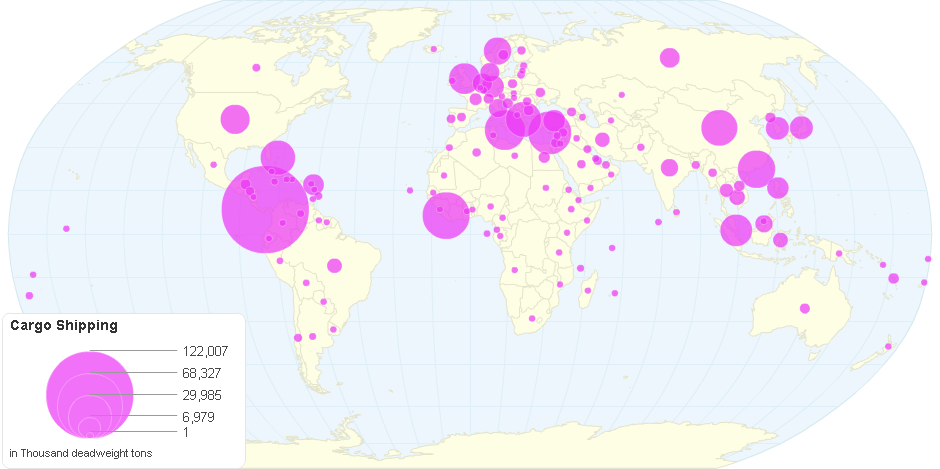This chart shows Cargo Shipping by Country.
A cargo ship or freighter is any sort of ship or vessel that carries cargo, goods, and materials from one port to another. Thousands of cargo carriers ply the world's seas and oceans each year, handling the bulk of international trade.
Cargo ships are usually specially designed for the task, often being equipped with cranes and other mechanisms to load and unload, and come in all sizes. Today, they are almost always built by welded steel, and with some exceptions generally have a life expectancy of 25 to 30 years before being scrapped.
Cargo ships/freighters can be divided into five groups, according to the type of cargo they carry. These groups are:
1. General cargo vessels
2. Tankers
3. Dry bulk carriers
4. Multi-purpose vessels
5. Reefer ships
General cargo vessels carry packaged items like chemicals, foods, furniture, machinery, motor- and military vehicles, footwear, garments, etc.Tankers carry petroleum products or other liquid cargo.Dry bulk carriers carry coal, grain, ore and other similar products in loose form.Multi-purpose vessels, as the name suggests, carry different classes of cargo – e.g. liquid and general cargo – at the same time.A Reefer ship is specifically designed and used for shipping perishable commodities which require temperature-controlled, mostly fruits, meat, fish, vegetables, dairy products and other foodstuffs.
Specialized types of cargo vessels include container ships and bulk carriers. Cargo ships fall into two further categories that reflect the services they offer to industry: liner and tramp services. Those on a fixed published schedule and fixed tariff rates are cargo liners. Tramp ships do not have fixed schedules. Users charter them to haul loads. Generally, the smaller shipping companies and private individuals operate tramp ships.
Due to its low cost, most large cargo vessels are powered by bunker fuel also known as Heavy Fuel Oil which contains higher sulphur levels than diesel.This level of pollution is accelerating:with bunker fuel consumption at 278 million tonnes per year, it is projected to be at 500 million tonnes per year in 2020.
International standards to dramatically reduce sulphur content in marine fuels and nitrogen oxide emissions have been put in place. Among some of the solutions offered is changing over the fuel intake to clean diesel or marine gas oil, while in restricted waters and Cold Ironing the ship while it is in port.
9 years ago

